
By Molly Shea - April 2014
PAPER CITATION
Tsurusaki, B. K. and Calabrese Barton, A. (2013). Using Transformative Boundary Objects to Create Critical Engagement in Science: A Case Study. Science Education 97(1), 1-31.
Research Design
The authors studied a sixth-grade science classroom to understand how a teacher leveraged a science curriculum and everyday tools in the community (i.e. bar graphs, science research questions, nutrition labels, public service announcements) to transform how students used knowledge from home and science class to develop critical science dispositions.
This qualitative study relied on participant observations, interviews, and artifact collection to study how science teachers can create spaces for students to critically analyze scientific materials related to everyday science and classroom science practices. The teacher, Mrs. Hanson, privileged science that emerged within communities and designed for classroom experiences that drew on student experiences. Specifically, Mrs. Hanson engaged students’ funds of knowledge about fast food diets and asked students to bring nutrition labels from home to critically analyze nutrition practices in the community. Students then created public health announcements to share what they had learned about healthy practices for their community. By drawing out student experiences and connecting them to science literacy practices, Mrs. Hanson created a space for students to participate in scientific understanding and debate that had consequences for other aspects of their lives.
The researchers were interested in how the teacher positioned student experiences as valuable tools for engaging in scientific conversations. Mrs. Hanson achieved this by asking students to introduce artifacts from their lives and their communities as central component for scientific inquiry in class. By bringing student expertise and materials from the community into class, the teacher created critically relevant pedagogy for kids to make sense of science and it’s relevance to other aspects of their lives.
Theoretical Basis
The research was grounded in sociocultural theory and Ladson-Billings’ work on Culturally Relevant Pedagogy (CRP). In particular, the authors related the classroom activities to the third tenet of CRP, which supports “developing a critical consciousness through which [students] challenge the status quo of the current social order” (Ladson-Billings, 1995a). The article uses this framework to describe how CRP could be enacted in a science classroom.
Tsurusaki et al. built on the notion of boundary objects, which were originally conceived in a museum study. Boundary objects are objects that hold different meanings in different social worlds but can travel across communities, depict bodies of knowledge, and still be general enough to embody ideas across contexts. For example, a map of a city can serve the city planning committee as well as the first grade classroom. In this case, the map can display the same information but serve as a reference point for different kinds of knowledge, conversations, and sense making in different contexts. The map as a boundary object can serve as a shared reference point that travels across communities. Based on their research, the authors introduce the notion of transformative boundary objects. These are objects that “not only coordinate activity and allow for knowledge integration across worlds but also allow for the transformation of either the participating communities or of the nature of the boundary itself” (Tsurusaki et al, 2013).
Summary of Results
Students’ knowledge and experiences of nutrition outside of the classroom became relevant to classroom science through the facilitated introduction of boundary objects from the community into class activities. Mrs. Hanson facilitated new connections across home, neighbourhood, and the science classroom by asking students, for example, to analyze and discuss the food pyramid (government document), record a 24-hour food journal (data collection from home), and create a bar graph as school to analyse the multiple sources of data. These moves sanctioned student experiences and legitimized their lives as possible sources of data and provided scientifically recommended practices against which to analyze. Students were then able to make connections to science-rich literature and their everyday practices. The boundary objects became powerful ideas that could facilitate the flow of ideas and inform the decisions students made in their lives beyond the classroom. What is more, the creation of a new boundary object in the form of a Public Health Announcement allowed students to utilize their new scientific understanding to guide their own practices and perhaps those of their community. The boundary objects became transformative as students reported adjusting their eating habits as a result of their new scientific understanding.
Implications
A larger question for scientific and education communities alike is how do we develop citizens that can participate in democratic decision-making based on how science relates to their lives and contributes to their civic responsibilities (Buxton, 2010; Polman, 2010; Rose, 2014).
For informal science educators looking to create experiences that help youth connect ideas about science across settings and deepen their experience as participants in scientific pursuits, educators can plan to introduce and make sense of objects like maps, news articles, and nutrition labels with youth. Additionally educators can work with young people and facilitate conversations about how these objects relate to informal setting as well as other places where youth engage with scientific content. This is particularly important for creating quality opportunities for students with different cultural practices, funds of knowledge, and relationships to place. In particular designing learning environments with boundary objects in mind can help facilitators connect scientific activities and concepts to other settings, invite multiple perspectives, and avenues for making meaning. Done well, these activities can inform scientific understanding and practices long-term.
This article is a case study describing how one science teacher makes everyday science and classroom science intersect. For educators in formal settings, this article is useful to help teachers adapt curriculums to relate information from home and neighborhoods to objects and tools used in science class. Across learning environments, the concept of transformative boundary objects is a useful concept to help educators design projects to help students make connections across places and publically engage with important science going on in their communities and around the world.




